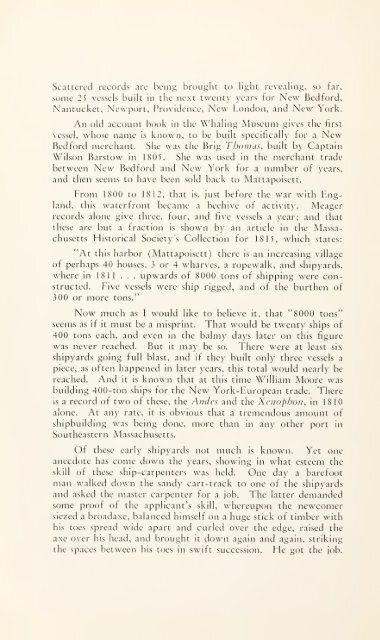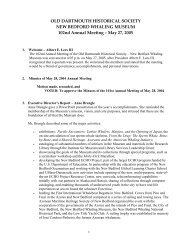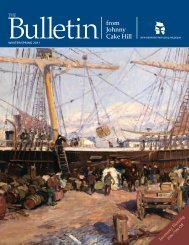Scattered records are being brought to light revealing, so far,some 2 5 vessels built in the next twenty years for <strong>New</strong> <strong>Bedford</strong>,Nantucket, <strong>New</strong>port, Providence, <strong>New</strong> London, and <strong>New</strong> York.An old account book in the <strong>Whaling</strong> <strong>Museum</strong> gives the firstvessel, whose name is known, to be built specifically for a <strong>New</strong><strong>Bedford</strong> merchant. She was the Brig Thonun, built by CaptainWilst)n Barstow in 1805. She was used in the merchant tradebetween <strong>New</strong> <strong>Bedford</strong> and <strong>New</strong> York for a number of years,and then seems to have been sold back to Mattapoisett.From 1800 to 1812, that is, just before the war with England,this waterfront became a beehive of activity. Meagerrecords alone give three, four, and live vessels a year; and thatthese are but a fraction is shown by an article in the MassachusettsHistorical Society's Collection for 1815, which states:"At this harbor (Mattapoisett) there is an increasing villageof perhaps 40 houses, 3 or 4 wharves, a ropewalk, and shipyards,where in 1811 upwards of 8000 tons of shipping were constructed.. . .Five vessels were ship rigged, and of the burthen of300 or more tons."Now much as I would like to believe it, that "8000 tons"seems as if it must be a misprint. That would be twenty ships of400 tons each, and even in the balmy days later on this figurewas never reached. But it may be so. There were at least sixshipyards going full blast, and if they built only three vessels apiece, as often happened in later years, this total would nearly bereached. And it is known that at this time William Moore wasbuilding 400-ton ships for the <strong>New</strong> York-European trade. Thereis a record of two of these, the Amies and the Xciiophoii, in 1810alone. At any rate, it is obvious that a tremendous amount ofshipbuilding was being done, more than in any other port inSoutheastern Massachusetts.Of these early shipyards not much is known. Yet oneanecdote has come down the years, showing in what esteem theskill of these ship-carpenters was held. One day a barefootman walked down the sandy cart-trackto one of the shipyardsand asked the master carpenter for a job. The latter demandedsome proof of the applicant's skill, whereupon the newcomersiezed a broadaxe, balanced himself on a huge stick of timber withhis toes spread wide apart and curled over the edge, raised theaxe over his head, and brought itdown again and again, strikingthe spaces between his toes in swift succession. He got the job.
This may or may not be an exaggeration. The skill ofthese ship-carpenters was something for us to marvel at. With afew crude tools — a broad axe, an adz, a chisel, a saw, and a hammer— they could fashion rough pieces of timber into a fleetsailing vessel. And "many a man among them could with thebroad axe hew so closely to the line, and so smoothly, that theplane could hardly improve the surface."The War of 1812, with H. M. Brig Niiinocl in Buzzards Bay,put a temporary crimp in activities; but after 1815 we cometo the 45 years when the American merchant fleet became thelargest in the world, and when <strong>New</strong> <strong>Bedford</strong> became the centerof the whaling industry, one of the great businesses of the world.As the years rolled on, Mattapoisett became the premier supplierof ships for that industry.Many of the vessels in the whaling fleetwere merchant shipsrebuilt and altered into whalers; but as the years went by, agentsrealized the wisdom of purchasing sturdy vessels built specificallyfor whaling by men experienced and skilled m the craft. Theseshipyards of high reputation for their whaleships lay almostwholly in Mattapoisett and within the confines of <strong>Old</strong> <strong>Dartmouth</strong>.Of the best known of these, one was in <strong>Dartmouth</strong>,three in <strong>New</strong> <strong>Bedford</strong>, two in Fairhaven, and five in Mattapoisett.And yet, during these years the population of Mattapoisett wasmuch smaller than any of the rest. She was, in truth, a villageof shipbuilders.Although a great deal is known of the 200-odd ships builtin Mattapoisett during these years, of their builders and theyards, and of the Nantucket and <strong>New</strong> <strong>Bedford</strong> firms for whichthey sailed, it is manifestly impossible in a short paper to speak ofeven a fraction of them; so I will give merely a resume of theshipyards and of those whalers which became well-known to<strong>New</strong> <strong>Bedford</strong> people.To the west of the present town wharves and extendingaround by the foot of Pearl St., lay the yard of Gideon BarstowSr., which later passed to his son Gideon Jr. and his grandsonWilson. Wilson Barstow's yard was one of the most noted ofits time. He was no business man — he failed three times —but he hired the finest master builders available, and for over aquarter of a century, down his ways slid three, four, and fiveships a year, and the majority sailed out of the harbor and aroundthe Neck to join the <strong>New</strong> <strong>Bedford</strong> and Fairhaven whaling
- Page 1 and 2: FJ2504-No.G'^
- Page 3: XSHIPBUILDERS OF MATTAPOISETTBy Cha
- Page 6 and 7: Edgartown, Dartmouth, Wcstport, New
- Page 8 and 9: and shoals, and the horrible menace
- Page 10 and 11: established shipyards and wharves,
- Page 12 and 13: shore, drew up to the house still s
- Page 16 and 17: fleets. From his yard, also, came t
- Page 18 and 19: Down at Cannonville at the foot of
- Page 20 and 21: iver." And in September 1828, the N
- Page 22: uilt by Barstow & Holmes in 1820. T
- Page 25 and 26: "A fine medium clipper ship of abou
- Page 27 and 28: Eliza, Si., 61 T., Abner Pc.isc (Pr
- Page 29 and 30: 1819Barclay, Ship, 301 T., Barstow
- Page 31 and 32: Mariner, Ship, 349 T., G. Barstow &
- Page 33 and 34: 1848Eliza, Sch., 139 T., N. H. liar
- Page 35 and 36: Reminiscences:ThreePUBLICATIONSOFTH
- Page 37: 52. The Arnold Mansion and Its Trad













